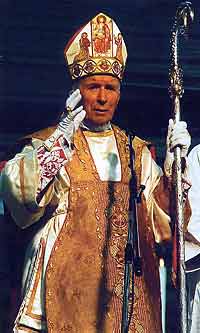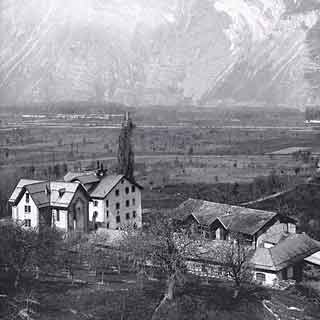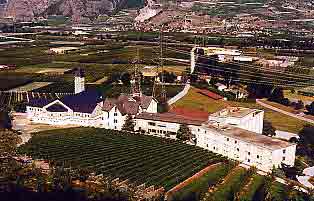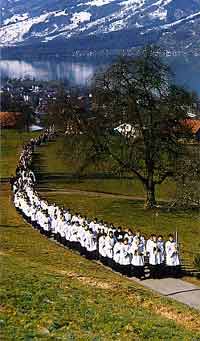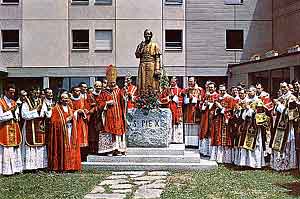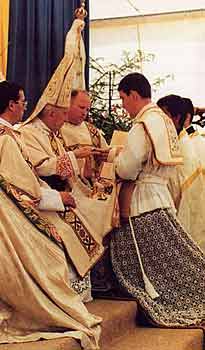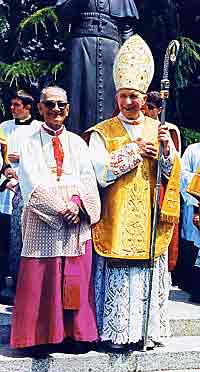

![]()
![]()
|
Religious
Communities for Men THE SOCIETY OF ST. PIUS X Its Founder Archbishop Marcel Lefebvre was born at Tourcoing in the Diocese of Lille, France, on November 29, 1905. Ordained to the priesthood on September 21, 1929, after a short stay in a French parish, urged by his missionary brother, he entered the novitiate of the Holy Ghost Fathers in 1931. Sent to Gabon in 1932, he was appointed Apostolic Vicar of Dakar and consecrated Bishop September 18, 1947, then enthroned Archbishop of Dakar on September 15, 1955. Having become Apostolic Delegate for all French-speaking Africa from 1948 to 1959, he was afterwards named Bishop of Tulle in 1962. During this same year, his colleagues elected him as Superior General of the Congregation of the Holy Ghost Fathers, the post from which he resigned following the aggiornamento begun by the Conciliar Church.
Archbishop
Lefebvre at his 60th anniversary of priesthood Having founded the Society of St. Pius X and undertook its government as Superior General from 1971 to 1983, he continued to assist the Society by his wise advices until his death on Monday of Holy Week, March 25, 1991, anniversary of the priestly ordination of the Sovereign Priest, Our Lord Jesus Christ. The Society The SOCIETY OF ST. PIUS X came into being after the II Vatican Council, at the request of seminarians desiring to be true priests according to the Tradition of the Church. Then, in view of the fact that it would be impossible to remain authentic priest when subjected to the ecclesiastical milieu of the dioceses, the idea of a priestly society was seen to be the best solution in order to be accepted by the bishops and protect their priesthood, while fulfilling a ministry much the same as secular priests.
"Let
all who are to be ordained priests approached!" On November 1, 1970, the Society was officially recognized by Bishop Charrière, Bishop of Fribourg in Switzerland; its constitution was warmly approved by Cardinal Wright, Prefect of the Congregation for the Clergy, the following February.
Ecône before its acquisition by the SSPX The traditional priestly formation accomplished at the Seminary of Ecône got to be known and eventually displeased and annoyed the French Bishops who feared the arrival in France of these young priests, trained in a traditional fashion. Thence came the pressure on Rome that ended in the illegal suppression of the Seminary (1975), and in the no less legal sanctions against the founder of the Society (1976).
Ecône today The Society has expanded rather rapidly and now (August 2000) includes more that 650 members, of whom 401 are priests, and 170 seminarians. The priests are distributed among the 6 seminaries and about 125 houses and churches, in 30 countries spread on the five continents.
Pilgrimage
to the Shrine of St Nicholas of Flüe, With his residence at the Mother House in Menzingen, Switzerland, the actual Superior General since 1994 is Bishop Bernard Fellay. He is assisted in his office by Fr Franz Schmidberger and Fr. Paul Aulagnier. The Society of St. Pius X is a Society with common life without vows, like the Sulpicians, the White Fathers, etc. Composed mainly of priests, the Society of St. Pius X also has religious members who are brothers, sisters, and oblates.
The controversial ordinations of June 29, 1976 The seminarians and priests, after a year of spirituality, publicly pronounce their commitment on December 8, each year, and after ten years of temporary membership may ask to make their final commitment. The Brothers of the Society of St. Pius X, after fulfilling a one-year postulate and a one-year novitiate, help the priests with various functions, be they apostolic works like catechism; or material tasks in order to unburden the priests from obstacles to their apostolate. They recite the Divine Office with the priests. They number about fifty today. The Society has associated itself with a society of sisters: the Sisters of the Society of St. Pius X, founded also by Archbishop Lefebvre in cooperation with his own sister Rev. Mother Marie Gabrielle. They enjoy their own canonical autonomy, have their own Mother Superior, but work in close union with the Priestly Society. After a six month postulate and a two year novitiate, they assist the priest with multiple tasks: primary schools, catechism, visit to the sick, sacristy, upkeep of the houses, especially in regards to the washing and if required, the cooking also. They also recite the Divine Office with the priests and brothers, and have a full hour of adoration each day. There are now 108 professed sisters, about 15 novices and postulants: they are dispersed in 19 houses of which the Mother House, 4 noviciates, 7 schools, 8 priories, a seminary, a retreat house, a nursing home, and a mission. The Society also accepts Oblate Sisters, who often are religious sisters, who have rejected the reforms destroying their former societies. They comprise also persons of over thirty years of age who are desirous of living in the spiritual setting of the Society under the authority of the priests. The Oblates have a year of postulate and a year of novitiate if they are not already religious sisters. These are admitted to the Oblation after one year of living in the community. And they too help the priests in the priories and seminaries. There are now 57 Oblates in the various houses of the Society. Finally, for persons desiring to share in the spiritual life of the Society while yet remaining in the world, a ‘Third Order’ has been established, in the broader sense of the word, in order to aid its members in living a Christian life for their personal sanctification, and the spiritual edification of their entourage.
Tradition of the instruments during an ordination (1986) The Spirit of the Society The dedicated spirit of the Society can be summarized as follows: To continue the sacred priesthood as it was instituted by Our Lord Jesus Christ and the priestly apostolate, according to the 2000 year old Tradition of the Church. But this Institution and this Tradition teach us that the raison d’être of a priest is to perpetuate the sacrifice of the redemption of Our Lord and to keep dispensing its fruit to all generations. From the pierced Heart of Our Lord flow the Church and all the Holy Sacraments through which Our Lord communicates His own Divine Life to souls and washes them of their sins. Thus, the sacrifice of the Mass is recognized as the inextinguishable source of the Church’s life, the great mystery of Faith, the synthesis of all revealed Truths, the fountain of all graces. Sacrifice and Sacrament, the Holy Mass brings the real Presence of Our Lord Jesus Christ among us, and communicates him as miraculous nourishment.
June
30, 1988: the two consecrating bishops, It is this sublime role of the priest that the Society has endeavored to perpetuate, being conscious also that this role is the source of the reign of Our Lord in our souls, in families and in society. It is to this “Restoration of all things in Christ”, with all its zeal, that the Society engages itself totally through its seminaries, colleges and universities, academies, high schools and grade schools, through its chapel and communities where retreats are held, and especially the Spiritual Exercises of St. Ignatius; and through its priories, real centers of apostolic missions. To foster its fervour the Society is attached to the great devotions of the Church in its liturgy; to the great mysteries of Our Lord, his Sacred Heart, to the Virgin Mary, and especially to Our Lady of Compassion; to St. Joseph, our prudent guide in spiritual and material works; to the Holy Angels, against all diabolical influence; to St. Pius X, to keep us in the Faith and sanctity, against the errors and vices of the modern world. In Asia, candidates should write to: The Vocation
Director e-mail: wailliez@mozcom.com Outside of Asia, write to either one of the following:
|
